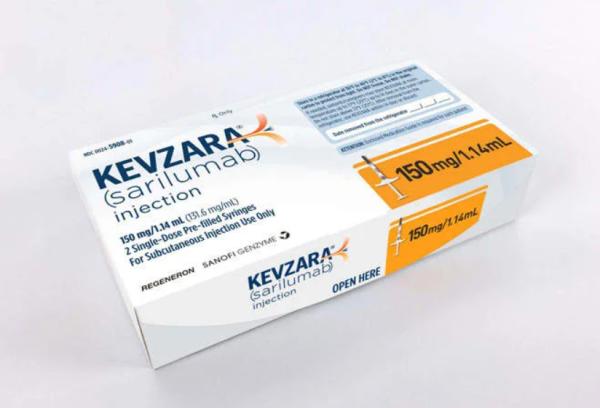Sarilumab Side Effects
Medically reviewed by Drugs.com. Last updated on Mar 8, 2024.
Applies to sarilumab: subcutaneous solution.
Warning
Subcutaneous route (Solution)
Risk of Serious InfectionsPatients treated with sarilumab are at increased risk for developing serious infections that may lead to hospitalization or death. Opportunistic infections have also been reported in patients receiving sarilumab. Most patients who developed infections were taking concomitant immunosuppressants such as methotrexate or corticosteroids.Avoid use of sarilumab in patients with an active infection.Reported infections include: Active tuberculosis, which may present with pulmonary or extrapulmonary disease. Patients should be tested for latent tuberculosis before sarilumab use and during therapy. Treatment for latent infection should be initiated prior to sarilumab use. Invasive fungal infections, such as candidiasis, and pneumocystis. Patients with invasive fungal infections may present with disseminated, rather than localized, disease. Bacterial, viral and other infections due to opportunistic pathogens.Closely monitor patients for signs and symptoms of infection during treatment with sarilumab. If a serious infection develops, interrupt sarilumab until the infection is controlled.Consider the risks and benefits of treatment with sarilumab prior to initiating therapy in patients with chronic or recurrent infection.
Serious side effects of Sarilumab
Along with its needed effects, sarilumab may cause some unwanted effects. Although not all of these side effects may occur, if they do occur they may need medical attention.
Check with your doctor immediately if any of the following side effects occur while taking sarilumab:
More common
- Bloody, black, or tarry stools
- chills
- cough
- fever
- lower back or side pain
- painful or difficult urination
- pale skin
- sore throat
- ulcers, sores, or white spots in the mouth
- unusual bleeding or bruising
- unusual tiredness or weakness
Less common
- Bladder pain
- bloody or cloudy urine
- body ache or pain
- difficulty breathing
- ear congestion
- frequent urge to urinate
- headache
- loss of voice
- painful cold sores or blisters on the lips
- sneezing
- stuffy or runny nose
Rare
- Chest tightness
- difficulty swallowing
- dizziness
- fast heartbeat
- heartburn
- hives, itching, skin rash
- indigestion
- nausea
- puffiness or swelling of the eyelids or around the eyes, face, lips, or tongue
- severe stomach pain, cramping, or burning
- vomiting of material that looks like coffee grounds, severe and continuing
Other side effects of Sarilumab
Some side effects of sarilumab may occur that usually do not need medical attention. These side effects may go away during treatment as your body adjusts to the medicine. Also, your health care professional may be able to tell you about ways to prevent or reduce some of these side effects.
Check with your health care professional if any of the following side effects continue or are bothersome or if you have any questions about them:
More common
- Bleeding, blistering, burning, coldness, discoloration of skin, feeling of pressure, infection, inflammation, itching, lumps, numbness, pain, rash, redness, scarring, soreness, stinging, swelling, tenderness, tingling, ulceration, or warmth at the injection site
For Healthcare Professionals
Applies to sarilumab: subcutaneous solution.
General
The most frequently reported side effects included infections, upper respiratory tract infections, urinary tract infections, nasopharyngitis, neutropenia, increased ALT, injection site erythema, leukopenia, injection site pruritus, constipation, pruritic rash, myalgia, and fatigue.
The most common side effects resulting in discontinuation were neutropenia, increased ALT, infection, COVID-19, intervertebral discitis, and pneumonia.[Ref]
Dermatologic
Common (1% to 10%): Erythema, pruritus, pruritic rash
Uncommon (0.1% to 1%): Cellulitis[Ref]
Gastrointestinal
Common (1% to 10%): Oral herpes, constipation, diarrhea
Uncommon (0.1% to 1%): Diverticulitis
Rare (0.01% to 0.1%): Gastrointestinal (GI) perforation[Ref]
Reports of GI perforation was primarily reported as complications of diverticulitis including lower GI perforation and abscess.[Ref]
Genitourinary
Common (1% to 10%): Urinary tract infection[Ref]
Hematologic
Very common (10% or more): Neutropenia
Common (1% to 10%): Leukopenia, thrombocytopenia
Uncommon (0.1% to 1%): Decreased platelet counts[Ref]
Hepatic
Very common (10% or more): Elevated ALT (up to 43%), elevated AST (up to 30%)
Common (1% to 10%): Transaminases increased[Ref]
Hypersensitivity
Uncommon (0.1% to 1%): Hypersensitivity reactions[Ref]
Immunologic
Common (1% to 10%): Serious infections
Frequency not reported: Immunosuppression[Ref]
Local
Common (1% to 10%): Injection site reactions, injection site erythema, injection site pruritus[Ref]
Metabolic
Common (1% to 10%): Lipid abnormalities, hypertriglyceridemia, hypercholesterolemia[Ref]
Lipid abnormalities included elevated low-density lipoprotein, high-density lipoprotein, and triglycerides.[Ref]
Musculoskeletal
Common (1% to 10%): Myalgia, rheumatoid arthritis
Frequency not reported: Intervertebral discitis
Nervous system
Common (1% to 10%): Headache
Respiratory
Common (1% to 10%): Upper respiratory tract infection, nasopharyngitis
Uncommon: Pneumonia
Frequency not reported: COVID-19, bronchitis, influenza[Ref]
Oncologic
Common (1% to 10%): Malignancies
Other
Common (1% to 10%): Fatigue
Frequency not reported: Herpes zoster, drug specific antibody
Frequently asked questions
- What are the new drugs for rheumatoid arthritis (RA)?
- How long does it take for Kevzara to work?
- Does Kevzara cause weight gain?
- How do you use Kevzara (sarilumab) for the treatment of rheumatoid arthritis?
More about sarilumab
- Check interactions
- Compare alternatives
- Reviews (29)
- Dosage information
- During pregnancy
- Drug class: antirheumatics
- Breastfeeding
- En español
Patient resources
Other brands
Professional resources
Other brands
Related treatment guides
References
1. (2017) "Product Information. Kevzara (sarilumab)." sanofi-aventis
2. (2023) "Product Information. Kevzara (sarilumab)." sanofi-aventis
Further information
Always consult your healthcare provider to ensure the information displayed on this page applies to your personal circumstances.
Some side effects may not be reported. You may report them to the FDA.

